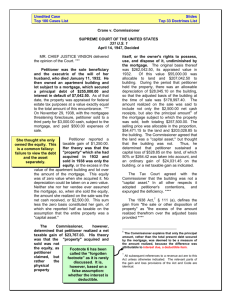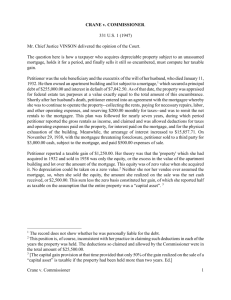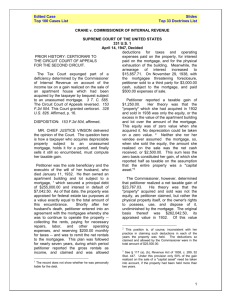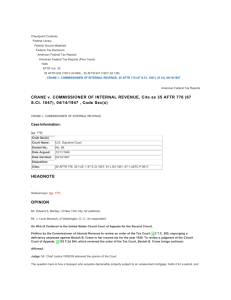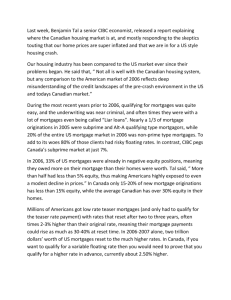CRANE v. COMMISSIONER SUPREME COURT OF THE UNITED
advertisement
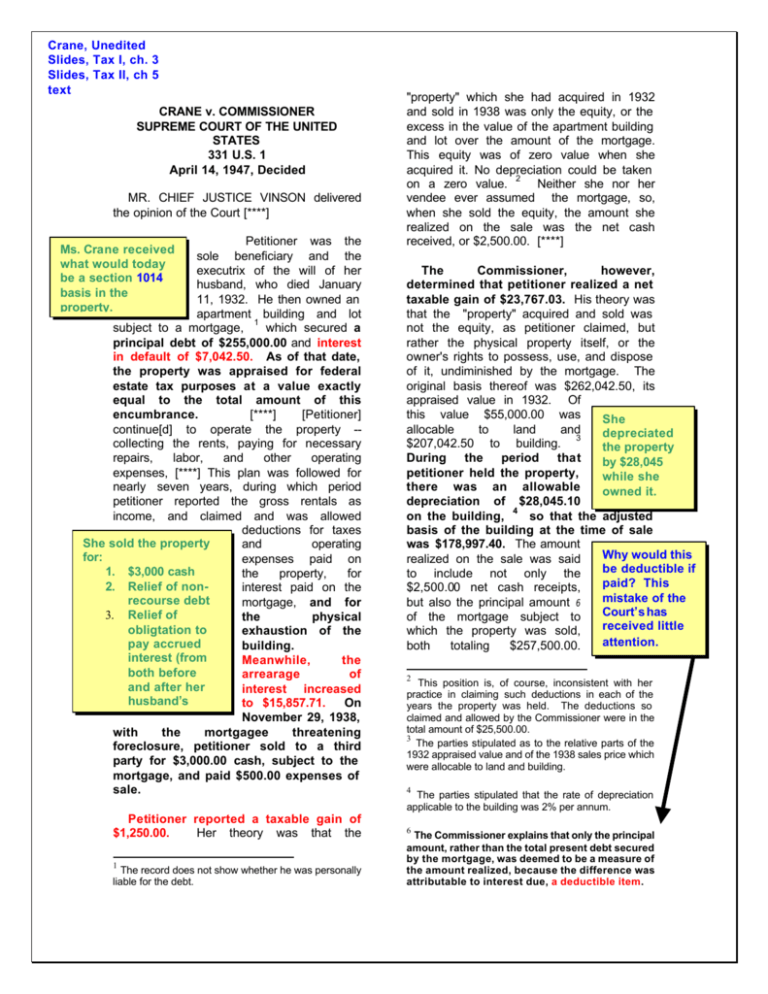
Crane, Unedited Slides, Tax I, ch. 3 Slides, Tax II, ch 5 text CRANE v. COMMISSIONER SUPREME COURT OF THE UNITED STATES 331 U.S. 1 April 14, 1947, Decided MR. CHIEF JUSTICE VINSON delivered the opinion of the Court [****] Petitioner was the sole beneficiary and the executrix of the will of her husband, who died January 11, 1932. He then owned an apartment building and lot 1 subject to a mortgage, which secured a principal debt of $255,000.00 and interest in default of $7,042.50. As of that date, the property was appraised for federal estate tax purposes at a value exactly equal to the total amount of this encumbrance. [****] [Petitioner] continue[d] to operate the property -collecting the rents, paying for necessary repairs, labor, and other operating expenses, [****] This plan was followed for nearly seven years, during which period petitioner reported the gross rentals as income, and claimed and was allowed deductions for taxes She sold the property and operating for: expenses paid on 1. $3,000 cash the property, for 2. Relief of noninterest paid on the recourse debt mortgage, and for 3. Relief of the physical obligtation to exhaustion of the pay accrued building. interest (from Meanwhile, the both before arrearage of and after her interest increased husband’s to $15,857.71. On November 29, 1938, with the mortgagee threatening foreclosure, petitioner sold to a third party for $3,000.00 cash, subject to the mortgage, and paid $500.00 expenses of sale. Ms. Crane received what would today be a section 1014 basis in the property. Petitioner reported a taxable gain of $1,250.00. Her theory was that the 1 The record does not show whether he was personally liable for the debt. "property" which she had acquired in 1932 and sold in 1938 was only the equity, or the excess in the value of the apartment building and lot over the amount of the mortgage. This equity was of zero value when she acquired it. No depreciation could be taken 2 on a zero value. Neither she nor her vendee ever assumed the mortgage, so, when she sold the equity, the amount she realized on the sale was the net cash received, or $2,500.00. [****] The Commissioner, however, determined that petitioner realized a net taxable gain of $23,767.03. His theory was that the "property" acquired and sold was not the equity, as petitioner claimed, but rather the physical property itself, or the owner's rights to possess, use, and dispose of it, undiminished by the mortgage. The original basis thereof was $262,042.50, its appraised value in 1932. Of this value $55,000.00 was She allocable to land and depreciated 3 $207,042.50 to building. the property During the period that by $28,045 petitioner held the property, while she there was an allowable owned it. depreciation of $28,045.10 4 on the building, so that the adjusted basis of the building at the time of sale was $178,997.40. The amount Why would this realized on the sale was said be deductible if to include not only the paid? This $2,500.00 net cash receipts, mistake of the but also the principal amount 6 Court’s has of the mortgage subject to received little which the property was sold, attention. both totaling $257,500.00. 2 This position is, of course, inconsistent with her practice in claiming such deductions in each of the years the property was held. The deductions so claimed and allowed by the Commissioner were in the total amount of $25,500.00. 3 The parties stipulated as to the relative parts of the 1932 appraised value and of the 1938 sales price which were allocable to land and building. 4 The parties stipulated that the rate of depreciation applicable to the building was 2% per annum. 6 The Commissioner explains that only the principal amount, rather than the total present debt secured by the mortgage, was deemed to be a measure of the amount realized, because the difference was attributable to interest due, a deductible item. [****] Logically, the first step [****] is to determine the unadjusted basis of the property [****] and the dispute in this case is as to the construction to be given the term "property." If "property," as used in that provision, means the same thing as "equity," it would necessarily follow that the basis of petitioner's property was zero, as she contends. If, on the contrary, it means the land and building themselves, or the owner's legal rights in them, undiminished by the mortgage, the basis was $262,042.50. We think that the reasons for favoring one of the latter constructions are of overwhelming weight. In the first place, the words of statutes -- including revenue acts -- should be interpreted where possible in their 6 ordinary, everyday senses. The only relevant definitions of "property" to be found 7 in the principal standard dictionaries are the two favored by the Commissioner, i. e., either that "property" is the physical thing which is a subject of ownership, or that it is the aggregate of the owner's rights to control and dispose of that thing. "Equity" is not given as a synonym, nor do either of the foregoing definitions suggest that it could be correctly so used. Indeed, "equity" is defined as "the value of a property . . . 8 above the total of the liens. . . ." The contradistinction could hardly be more pointed. Strong countervailing considerations would be required to support a contention that Congress, in using the word "property," meant "equity," or that we should impute to it the intent to convey that 9 meaning. "equity" is the bearing such construction would have on the allowance of deductions for depreciation and on the collateral adjustments of basis. [****] Under these provisions, if the mortgagor's equity were the § 113 (a) basis, it would also be the original basis from which depreciation allowances are deducted. If it is, and if the amount of the annual allowances were to be computed on that value, as would then 10 seem to be required, they will represent only a fraction of the cost of the corresponding physical exhaustion, and any recoupment by the mortgagor of the remainder of that cost can be effected only by the reduction of his taxable gain in the 11 year of sale. If, however, the amount of the annual allowances were to be computed on the value of the property, and then deducted from an equity basis, we would in some instances have to accept deductions from a minus basis or deny deductions 12 altogether. The Commissioner also argues that taking the mortgagor's equity as the § 113 (a) basis would require the basis to be changed with each payment 10 Secs. 23 (n) and 114 (a), in defining the "basis upon which" depreciation is "to be allowed," do not distinguish between basis as the minuend from which the allowances are to be deducted, and as the dividend from which the amount of the allowance is to be computed. The Regulations indicate that the basis of property is the same for both purposes. Reg. 101, Art. 23 (l)-4, 5. [****] 11 A further reason why the word "property" in § 113 (a) should not be construed to mean 6 Old Colony R. Co. v. Commissioner, 284 U.S. 552, 560. 7 See Webster's New International Dictionary, Unabridged, 2d Ed.; Funk & Wagnalls' New Standard Dictionary; Oxford English Dictionary. 8 See Webster's New International Dictionary, supra. 9 Crooks v. Harrelson, 282 U.S. 55, 59. This is contrary to Treasury practice, and to Reg. 101, Art. 23 (l)-5, which provides in part: "The capital sum to be recovered shall be charged off over the useful life of the property, either in equal annual installments or in accordance with any other recognized trade practice, such as an apportionment of the capital sum over units of production." See Detroit Edison Co. v. Commissioner, 319 U.S. 98, 101. 12 So long as the mortgagor remains in possession, the mortgagee can not take depreciation deductions, even if he is the one who actually sustains the capital loss, as § 23 (l) allows them only on property "used in the trade or business." 13 on the mortgage, and that the attendant problem of repeatedly recomputing basis and annual allowances would be a tremendous accounting burden on both the Commissioner and the taxpayer. Moreover, the mortgagor would acquire control over the timing of his depreciation allowances. [****] We conclude that the proper basis under § 113 (a) (5) is the value of the property, undiminished by mortgages thereon, and that the correct basis here was $262,042.50. The next step is to ascertain what adjustments are required under § 113 (b). As the depreciation rate was stipulated, the only question at this point is whether the Commissioner was warranted in making any depreciation adjustments whatsoever. [****] At last we come to the problem of determining the "amount realized" on the 1938 sale. Section 111 (b), it will be recalled, defines the "amount realized" from "the sale . . . of property" as "the sum of any money received plus the fair market value of the property (other than money) received," and § 111 (a) defines the gain on "the sale . . . of property" as the excess of the amount realized over the basis. Quite obviously, the word "property," used here with reference to a sale, must mean "property" in the same ordinary sense intended by the use of the word with reference to acquisition and depreciation in § 113, both for certain of the reasons stated heretofore in discussing its meaning in § 113, and also because the functional relation of the two sections requires that the word mean the same in one section that it does in the other. If the "property" to be valued on the date of acquisition is the property free of liens, the "property" to be priced on a subsequent sale must be the same thing. Starting from this point, we could not accept petitioner's contention that the $2,500.00 net cash was all she realized on the sale except on the absurdity that she sold a quarter-of-a-million dollar property for roughly one per cent of its value, and took a 99 per cent loss. Actually, petitioner does not urge this. She argues, conversely, that because only $2,500.00 was realized on the sale, the "property" sold must have been the equity only, and that consequently we are forced to accept her contention as to the meaning of "property" in § 113. We adhere, however, to what we have already said on the meaning of "property," and we find that the absurdity is avoided by our conclusion that the amount of the mortgage is properly included in the "amount realized" on the sale. Petitioner concedes that if she had been personally liable on the mortgage and the purchaser had either paid or assumed it, the amount so paid or assumed would be considered a part of the "amount realized" [****] Both these points apply to this case. The first has been mentioned already. As for the second, we think that a mortgagor, not This is the holding. personally liable on the debt, who sells the property subject to the mortgage and for additional This footnote consideration, realizes a benefit promted the in the amount of the mortgage Tufts decision as well as the boot.37 If a more than 3 purchaser pays boot, it is decades later. immaterial as to our problem We are not troubled by petitioner's argument that her contract of sale expressly provided for the conveyance of the equity only. She actually conveyed title to the property, and the buyer took the same property that petitioner had acquired in 1932 and used in her trade or business until its sale. 14 37 13 Sec. 113 (b) (1) (A) requires adjustment of basis "for expenditures . . . properly chargeable to capital account . . . ." 14 See Maguire v. Commissioner, 313 U.S. 1, 8. Obviously, if the value of the property is less than the amount of the mortgage, a mortgagor who is not personally liable cannot realize a benefit equal to the mortgage. Consequently, a different problem might be encountered where a mortgagor abandoned the property or transferred it subject to the mortgage without receiving boot. That is not this case. whether the mortgagor is also to receive money from the purchaser to discharge the mortgage prior to sale, or whether he is merely to transfer subject to the mortgage -it may make a difference to the purchaser and to the mortgagee, but not to the mortgagor. Or put in another way, we are no more concerned with whether the mortgagor is, strictly speaking, a debtor on the mortgage, than we are with whether the benefit to him is, strictly speaking, a receipt of money or property. We are rather concerned with the reality that an owner of property, mortgaged at a figure less than that at which the property will sell, must and will treat the conditions of the mortgage exactly as if they were his 15 personal obligations. If he transfers subject to the mortgage, the benefit to him is as real and substantial as if the mortgage were discharged, or as if a personal debt in an equal amount had been assumed by another. within the meaning of the Sixteenth Amendment. If this is because only the direct receipt of cash is thought to be income in the constitutional sense, her 18 contention is wholly without merit. If it is because the entire transaction is thought to have been "by all dictates of common sense . . . a ruinous disaster," as it was termed in her brief, we disagree with her premise. She was entitled to depreciation deductions for a period of nearly seven years, and she actually took them in almost the allowable amount. The crux of this case, really, is whether the law permits her to exclude allowable deductions from 19 consideration in computing gain. We have already showed that, if it does, the taxpayer can enjoy a double deduction, in effect, on the same loss of assets. The Sixteenth Amendment does not require that result any more than does the Act itself. Therefore we conclude that the Commissioner was right in determining that petitioner realized $257,500.00 on the sale of this property. DISSENTBY: JACKSON The Tax Court's contrary determinations, that "property," as used in § 113 (a) and related sections, means "equity," and that the amount of a mortgage subject to which property is sold is not the measure of a benefit realized, within the meaning of § 111 (b), announced rules of general applicability 16 on clear-cut questions of law. The Circuit Court of Appeals therefore had jurisdiction to 17 review them. [****] Affirmed. DISSENT: dissenting. MR. JUSTICE JACKSON, Petitioner contends that the result we have reached taxes her on what is not income 18 15 For instance, this petitioner returned the gross rentals as her own income, and out of them paid interest on the mortgage, on which she claimed and was allowed deductions. See Reg. 77, Art. 141; Reg. 86, Art. 23 (b)-1; Reg. 94, Art. 23 (b)-1; Reg. 101, Art. 23 (b)-1. 16 See Commissioner v. Wilcox, 327 U.S. 404, 410; Trust of Bingham v. Commissioner, 325 U.S. 365, 369372. Cf. John Kelley Co. v. Commissioner, 326 U.S. 521, 527; Dobson v. Commissioner, 320 U.S. 489. 17 Ibid; see also § 1141 (a) and (c), I. R. C. Douglas v. Willcuts, supra, 296 U.S. at 9; Burnet v. Wells, 289 U.S. 670, 677. 19 In the course of the argument some reference was made, as by analogy, to a situation in which a taxpayer acquired by devise property subject to a mortgage in an amount greater than the then value of the property, and later transferred it to a third person, still subject to the mortgage, and for a cash boot. Whether or not the difference between the value of the property on acquisition and the amount of the mortgage would in that situation constitute either statutory or constitutional income is a question which is different from the one before us, and which we need not presently answer.

